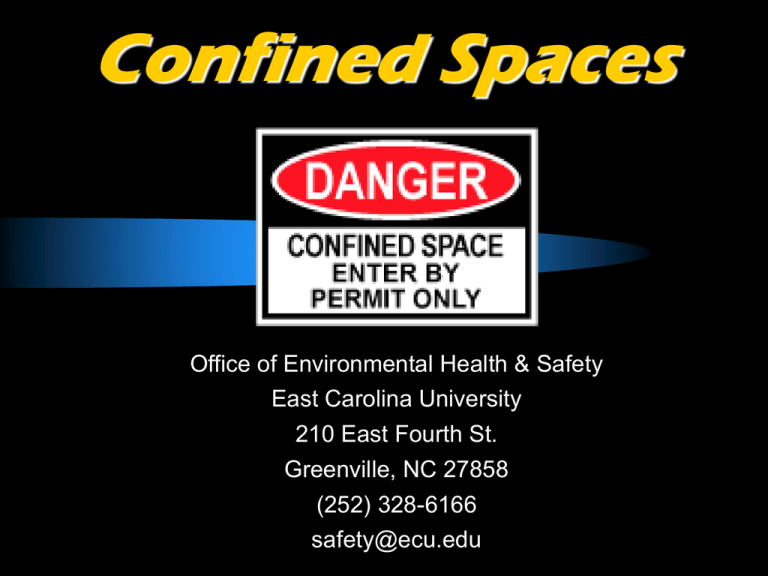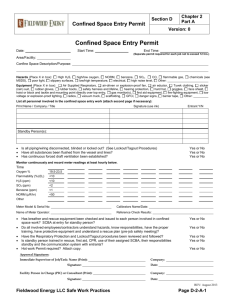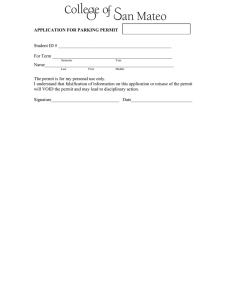Confined Space
advertisement

Confined Spaces Office of Environmental Health & Safety East Carolina University 210 East Fourth St. Greenville, NC 27858 (252) 328-6166 safety@ecu.edu Rescuers Account for Over 60% of Confined Space Fatalities Confined Space Tragedies o Three construction supervisors die from asphyxiation in a manhole. Oxygen levels 18.5 – 20 and Methane levels 300 – 600 ppm Training Outline What is a Confined Space? Confined Spaces on Campus Confined Space Hazards PPE & Equipment Requirements The Entry Permit Duties of Authorized Entrants, Attendants and Entry Supervisor o Rescue and Emergency Services o Contractors o o o o o o Regulatory Requirement o OSHA 29 CFR 1910.146: Permit- Required Confined Spaces - (Jan 1993) o Identify Confined Spaces in Workplace o Identify hazards in these spaces o Identify procedures for controlling these hazards o Train employees on confined space entry o Keep records of compliance & training for all confined space activities What is a Confined Space? o Large enough that an employee can enter and perform assigned work o Has limited or restricted means for entry or exit o Not designed for continuous employee occupancy Examples o tanks o pits o tunnels o vaults o boilers o sewers o shafts o ventilation ducts o crawl spaces Permit-Required Confined Space o Contains or has the potential to contain a hazardous atmosphere o Contains a material that has the potential for engulfing an entrant o Internal configuration that might cause entrant to be trapped or asphyxiated by inwardly converging walls or floor that slopes downward and tapers to a smaller cross section o Contains any other recognized serious safety or health hazard ECU Confined Spaces Main Campus Name Description Location Permit Required Space Boilers # 1-4 Boiler 14th St. Steam Plant Yes DA Tank Tank 14th St. Steam Plant Yes Condensate Tank Tank 14th St. Steam Plant Yes Steam Tunnel Manhole Main Campus Yes All Steam Manholes Manhole Main Campus Yes All Electrical Manholes Manhole Main Campus Yes All Sanitary Sewer Manholes Manhole Main Campus Yes All Storm Sewer Manholes Manhole Main Campus Yes Crawl Space Main Campus No Crawl Spaces Surge Tank Vault Student Rec Center No Steam Cloud Vault Joyner Library Plaza No ECU Confined Spaces Health Sciences Campus Name Description Location Permit Required Space Manhole HSC Yes Open Lines HSC No Backflow Vault - LSA #2 Vault HSC No Backflow Vault - behind Steam Plant Vault HSC No Boilers (#1, 2, & 3) Boiler Utility Plant Yes Chamber Utility Plant Yes Tank Utility Plant Yes Pipe Chase by HVAC Office VS Utility Plant Yes High Voltage Under Main Switch Gear VT Utility Plant Yes Fume Exhaust Plenum Roof VB Brody Yes 8th Floor Mech. Rm P3 Exhaust Plenum VS Brody Yes Mech Rm 003 1st Floor Pit Biotech No Tank Warren Life Sciences Yes Mech Rm 155 Pit Pit Warren Life Sciences No Courtyard Steam Pit Pit Leo Jenkins Yes All Manholes and Pits Manhole West Research Yes All Manholes All Storm Drain Lines Incinerator (Upper & Lower Chambers) DA Tank Mech Rm 155 Tank Atmospheric Hazards o Oxygen Levels - below 19.5 % or above 23.5% o Flammable/Explosive – exceeds 10% of Lower Explosive Limit (LEL) o Toxic Substances – exceed Permissible Exposure Limits (PEL) Oxygen Deficiency o Normal air contains 21% Oxygen (O2). An O2 level of 19.5% or less is considered O2 deficient. o A reduction in O2 can be caused by rusting, decomposition, or replacement by another gas. o Lack of O2 can cause a person to collapse and die. Oxygen Deficiency Oxygen Content Signs and Symptoms (% by volume) (at Atmospheric Pressure) 19.5% 17% 14-16% 12% Minimum permissible levels that work can be performed without respirators. Below this level, workers shall be required to wear supplied air respirators. Hypoxia symptoms, accelerated breathing and heart rate appear Accelerated breathing, increased heart rate, poor muscular coordination, fatigue, impaired perception and judgment. Unconsciousness without warning, poor judgment, blue lips 6-10% Nausea, vomiting, and unconsciousness; 8 minutes 100% fatal; 6 minutes, 50% fatal; 4-5 minutes, recovery with treatment. <6% Coma in 40 seconds, spasmatic breathing, convulsions, and death Oxygen Enrichment o O2 levels above 23.5% are considered “Oxygen Enriched.” o Oxygen Enriched atmospheres create fire and explosion hazards. o Cause flammable materials such as clothing to burn rapidly when ignited and may cause non-flammable materials to ignite. Hydrogen Sulfide Exposure Concentration Effect 1 ppm Smell of rotten egg 10 ppm 8 hr. TWA 15 ppm 15 min. STEL 100 ppm Lose sense of smell 300 ppm Loss of consciousness (approx. 20 min.) 1000 ppm Immediate respiratory arrest, loss of consciousness, followed by death Carbon Monoxide Exposure Concentration Effect 35 ppm 8 hr. TWA 200 ppm Ceiling, faint signs of discomfort may begin to appear 600 ppm Headache and discomfort after 1 hour 2500 ppm Loss of consciousness after approximately 30 minutes 4000 ppm Quickly fatal CO Poisoning can be reversed if caught in time. Welding in Confined Spaces o Continuous ventilation should be provided in the confined space. Pure oxygen should never be used for ventilation. o Conduct continuous monitoring throughout the entry to ensure that the area remains safe for entrants. o Gas cylinders and welding power sources should remain outside the confined space. Remember to follow all Confined Space Entry and Welding Safety Guidelines Physical Hazards o Engulfment o Temperature Extremes o Electrical Hazards o Noise o Slippery Surfaces Entry o "Entry" is when a person passes through an opening into a permitrequired confined space o Any part of the entrant's body breaks the plane of an opening into the space Before Entry o Ventilate, eliminate, or control the space’s atmospheric hazards o Blind or disconnect and cap all input lines so that no hazardous materials can enter the space o Lockout/Tagout o When entrance covers are removed, guard the opening immediately Atmospheric Monitoring o Test permit space before entry o Periodically monitor permit space to determine if entry conditions are maintained o Test all areas (top, middle, & bottom) o Observe status of existing hazards and those created during entry operations Personal Protective Equipment (PPE) o Full-body Harness o Respirator (half-mask, PAPR, Air-line Respirator, etc.) o Tyvek Suit o Gloves (Nitrile, Welding, etc.) o Safety Glasses/Goggles Equipment Requirements o Testing and monitoring o o o o o o o equipment Ventilating equipment Communications equipment Lighting equipment Barriers Equipment needed for safe entry and exit Emergency equipment Other equipment for safe entry The Entry Permit o Permit must be completed before entry is authorized o Entry supervisor must sign the permit o Permit must be made available at the time of entry so entrants can confirm that pre-entry preparations have been completed The Entry Permit o Duration may not exceed the time identified on the permit o Retain each canceled entry permit for at least 1 year to facilitate review of the program o Problems encountered during entry shall be noted on the permit so that appropriate revisions can be made to the program Contents of The Entry Permit 1. Permit space to be entered 2. Purpose of the entry 3. Date and the authorized duration of the entry permit 4. Authorized entrants 5. Attendants 6. Entry supervisor with a space for the signature Contents of The Entry Permit 7. Hazards of the permit space 8. Measures used to isolate the permit space and to eliminate or control permit space hazards before entry 9. Acceptable entry conditions 10. Results of initial and periodic tests, names or initials of the testers and when the tests were performed Contents of The Entry Permit 11. Rescue and emergency services 12. Communication procedures 13. Equipment (personal protective equipment, testing equipment, communications equipment, alarm systems, rescue equipment, etc.) 14. Any other information necessary in order to ensure employee safety Duties of Authorized Entrants o Understand all potential hazards o Know what equipment to use & how to use it properly o Communicate with attendant regularly o If the unexpected occurs – alert the attendant Duties of Authorized Entrants EVACUATE the confined space when: o Order to evacuate is given by the attendant or the entry supervisor o Entrant recognizes any warning sign or symptom of exposure to a dangerous situation o Evacuation alarm is activated Duties of Attendants o "Attendant" - stationed outside permit space; monitors entrants o Know the hazards including signs, symptoms and consequences of exposure o Continuously maintains accurate count of entrants in permit space o Remains outside the permit space during entry until relieved by another attendant Duties of Attendants o Communicate with entrants to monitor o o o o entrant status and to alert entrants if the need to evacuate arises Monitor activities inside & outside the space and keep unauthorized individuals away. Summon Emergency Services Perform non-entry rescues when applicable and they have training Perform no duties that might interfere with primary duty to monitor and protect entrants Duties of Entry Supervisor o "Entry supervisor" - person responsible for determining if acceptable entry conditions are present, for authorizing entry, overseeing entry operations, and for terminating entry as required o An entry supervisor also may serve as an attendant or as an entrant, as long as that person is trained and equipped to do so o Know the hazards including signs, symptoms, and consequences of exposure Duties of Entry Supervisor o Verify that the entry permit is complete, all tests have been conducted and all procedures and equipment are in place before allowing entry to begin o Verify that rescue services are available and that the means for summoning them are operable o Remove unauthorized individuals who enter or attempt to enter the space Rescue and Emergency Services o Self-Rescue o Non-entry Rescue o Greenville Fire/Rescue – Call 911 o ECU shall inform GFR of the hazards they may encounter on site o Provide the rescue provider with access to all permit spaces so they can develop rescue plans and practice rescue operations Rescue Equipment o Each entrant shall use a full body harness (and a retrieval line if feasible) o A mechanical retrieval device (Tripod) shall be available for vertical type permit spaces more than 5 feet deep o Retrieval systems shall be used unless they increase the overall risk of entry or would not contribute to the rescue Program Review o Review entry operations when there is reason to believe that measures taken may not protect employees and revise the program before subsequent entries o Review the permit space program annually and revise the program as necessary to ensure that employees participating in entry operations are protected o If you have any questions, concerns, or recommendations let your supervisor and/or EH&S know. ECU Shall… o Inform contractor that workplace contains permit spaces and entry is allowed only in compliance with permit space program o Inform contractor of the hazards that make the space a permit space o Inform contractor of precautions for the protection of employees in or near permit spaces where they will be working o Coordinate entry operations with the contractor, when both University personnel and contractor personnel will be working in or near permit spaces. Contractors Shall… o All contractors performing work in Confined o o o o Spaces on ECU Campus must have a Confined Space Program. Contractors must have their own equipment including monitoring device and rescue equipment. Coordinate with employer when both host personnel and contractor personnel will be working in or near spaces Debrief employer at the conclusion of entry Contractor shall inform the employer of the of any hazards confronted or created QUESTIONS? safety@ecu.edu 328-6166 Click the link to complete the Quiz

